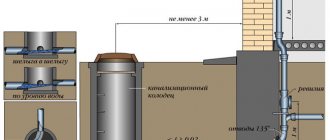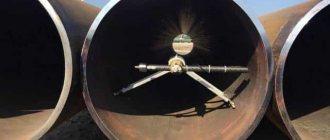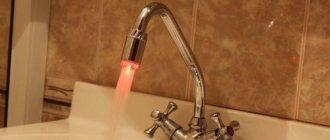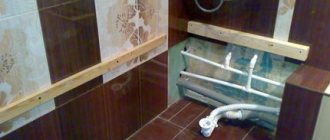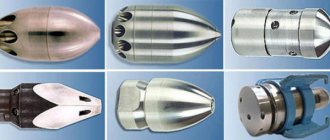Sewerage is a very important communications system in any modern residential or non-residential premises. Therefore, it is useful to have an idea of what types of sewerage exist and what types of sewerage are used in different premises.
Today the following classification of sewerage systems is used:
- Industrial sewerage , the main purpose of which is the treatment of industrial wastewater;
- Domestic sewerage , which can serve either an entire settlement (centralized) or a separate building or group of buildings (local);
- Stormwater, which serves to remove water accumulated as a result of rain from streets and roofs of houses.
Regardless of the type of sewerage, a distinction is also made between external and internal sewerage:
- External sewerage is located outside the premises and includes pumping stations, pipelines and treatment facilities.
- Internal sewerage is located inside a building or structure and consists of pipelines and household and plumbing fixtures connected to them.
In turn, external sewerage can be divided into three types:
- All-alloy sewer system, in which all types of wastewater (domestic, storm and utility) are transported together;
- Separate , in which the transportation of household wastewater is carried out separately from storm water;
- A semi-separate sewer system in which wastewater is transported separately to a common sewer where it is eventually combined.
Types of sewer systems used in the arrangement of a country house or cottage
Water purification system
Most often, in country and cottage villages there is no centralized sewer system, which leads to the need to organize an autonomous sewer system.
There are several types of such sewer systems:
- The cheapest, but also the least convenient option to use is a cesspool ;
- Dry toilets do not require installation work, but they force you to regularly purchase various materials used for recycling waste, after which the problem of their disposal also arises;
- A septic tank is a fairly popular device because, without requiring frequent waste removal, it cleans wastewater by approximately 75%. In addition, it is enough to clean the septic tank itself once every 1-2 years;
- Filters and devices in which deep wastewater treatment is carried out using biological material. The high quality of cleaning is balanced by the high cost of these devices.
When installing an autonomous sewer system, the method of transporting wastewater is also important: will it move by gravity or using pumps.
History of origin
The history of sewerage goes back many centuries. The oldest known system is the one in the ancient Indian city of Mohenjo-Daro, which was discovered during excavations. It is about 4600 years old. Systems are known in Ancient Rome (a striking example is the Great Cloaca, which still operates today, serving as a storm sewer) or Ancient China (in the city of Linzi). The description of these finds indicates
Medieval Europe lagged noticeably behind in this regard, since the invasion of barbarians swept away almost all the remains of Roman buildings, and there was no one to maintain and generally deal with social systems. The re-emergence of the network, which occurred at the end of the 17th century, was forced, caused by epidemics of infectious diseases that brought the entire European civilization to the brink of extinction.
In Russia, the history of sewerage is similar to Europe. The wastewater disposal systems were built according to the Roman style, but the use of wood instead of marble made them short-lived, and during the reign of Ivan the Terrible they were abandoned. This led to an outbreak of plague at the end of the 18th century. It is known that in Moscow neither water supply nor sewerage were fully created until the very beginning of the 20th century.
In the modern world, the development of sewer systems, thanks to technological advances, has been brought to perfection. New plumbing devices, materials, methods of processing and disposal of waste have appeared. Standards and requirements have been developed for sanitary and technical support of systems, violation of which threatens with serious penalties or even criminal prosecution.
Gravity sewer systems
The most popular type of sewer system for self-organization is gravity sewerage, in which wastewater, under the influence of gravity, moves into a sump through pipes laid at a certain slope.
The advantages of such a sewerage system are its low cost, ease of maintenance and independence from external energy sources, and the only disadvantage is that the sump must be located at a limited distance from the drains.
The slope of sewer pipes in such a system is selected in accordance with their diameter.
A pipe slope that is too small can cause solids to settle in the pipe, causing it to become clogged, while a slope that is too large can interfere with the transport of wastewater, in addition, the sump pit will have to be located deeper.
Rain and melt water
Rainwater is formed as a result of precipitation. They are divided into rain and melt, resulting from the melting of ice and snow. A distinctive feature of rainwater runoff is its episodic nature and sharp unevenness. Water from washing and watering streets and drainages is close to rainwater in terms of the qualitative characteristics of pollutants and is removed together with it.
Sewerage without the use of treatment facilities
Sewage pits
The main advantages of such systems are their low cost and simplicity of equipment - it’s unlikely that anyone needs a long explanation of how to make a sewer pit in which a wastewater tank will be placed.
The dimensions of the pit are set depending on the pre-calculated amount of waste; the tank can either be made independently from bricks or reinforced concrete rings, or a ready-made plastic container can be supplied.
The negative aspects include the fact that to pump out wastewater you will have to regularly resort to sewerage services, and if the tank turns out to be leaky, the wastewater will be partially filtered into the soil, which will negatively affect the environmental situation on the site.
How are complexes selected?
Before purchasing systems, be sure to communicate with specialists and managers of the company from which you are going to order the equipment. When choosing, you need to consider the following important factors:
- the depth at which communications (pipelines) are laid;
- environmental features;
- degree of saturation of pollutants in water;
- productivity of existing treatment facilities.
Stormwater treatment plants must be able to handle the load and effectively remove contaminants from the water. As practice shows, before purchasing complexes it is necessary to carry out appropriate calculations. For example, you need to find out the flow of wastewater, the rate of precipitation for each month and the SNiP coefficient, which determines the surface of the water. The dimensions of the complex largely depend on the drainage area, weather conditions, the characteristics of the facility where they will be installed, and, naturally, the location of the water discharge. Only after competent calculations carried out by specialists is a model selected.
Sewerage using septic tanks
Sewage systems that use a septic tank allow wastewater to be treated in several stages.
First of all, we should briefly explain what a septic tank is.
A septic tank is a device for treating wastewater, divided into several chambers for settling, filtering and processing, after which the purified water is discharged into a natural reservoir or a special filtration well.
Moreover, the number of chambers in the septic tank directly affects the quality of water purification.
Tip: for the highest quality wastewater treatment in a septic tank, sealed devices are used that use biological materials to process wastewater.
The use of such devices allows the use of recycled water for various purposes, except for drinking.
Criteria for selecting a filter device
Now you can proceed to choosing a filter device. Without this, it is impossible to properly install a sewer system for a private home.
For modern domestic installations, in most cases the following are used:
FC (filtration well). It is done only on sand and sandy loam - soils that absorb moisture well - SNiP 2.04.03-85 “Sewerage” insists on this. External networks and structures.” The amount of wastewater should not be more than a cubic meter per knock, and the base of the well must be placed at a distance of at least a meter from the water main water supply.
Sand and gravel filters and filter trenches. Suitable if the amount of wastewater is no more than 15 cubic meters per day, they are made in waterproof and low-filtration soils (rock, clay and loam. The highest level of groundwater level is a meter below the drainage tray.
Infiltrators, drainage blocks, drainage tunnels can be made in any type of soil, and the blocks can be connected to each other.
Sewage equipment in the bathhouse
Approximate diagram of a bathhouse sewerage system
Drainage type sewers are the most popular sewage system in a bathhouse due to its simplicity and economic efficiency.
Such a bathhouse sewerage system provides for the gravity transportation of wastewater to the sump, which is achieved by a certain slope of the floors in the washing rooms and steam room, allowing the water to flow into the drainage hole.
Through the hole, water enters a gutter made of galvanized metal or asbestos cement, along the gutter into a sewer pipe, from which the waste water finally ends up in a drainage well, which should not be located at a significant distance from the bathhouse.
The size of the drainage well is set in accordance with the preliminary calculation of water consumption; the diameter of the well must be at least one meter.
Important: the depth of the drainage well must be at least 50 centimeters greater than the soil freezing depth, which can be clarified in specialized literature.
The bottom of the hole for the drainage well is filled with expanded clay or other material with similar properties, covered with soil on top and compacted.
Checklist for beginners
It is impossible to decide on the type of waste disposal device until you describe in detail the conditions of its operation that exist on the site. A member of our portal with the nickname sonder RZN has compiled a checklist for those who are choosing and considering a sewerage scheme in a private house. It doesn’t matter whether you do it yourself or with the help of specialists: these questions still need to be answered.
- Determine the type of soil on the site. This can be done at home - just roll the soil into a sausage.
Geolog197FORUMHOUSE Member
If, with a length of 1 cm, the thickness is more than 3 mm, then it falls apart, then it is sandy loam; 1-3 mm is loam, less is clay. If the sausage doesn't roll, it's sand.
It is also necessary to do a test for water absorption: dig a hole 0.5 X 0.5 m, 1 meter deep, pour water into it, note the time and measure the speed at which it leaves. An estimate like “all the water was gone in three hours” is enough. If this is not enough, you can independently calculate the filtration coefficient using a simplified scheme available to every summer resident.
- Determine the level of groundwater and flood waters in the area, understand what the level of high water is.
- Draw up a site plan. It is important that this design indicates neighboring properties and adjacent roads.
- Determine the topography of the site and the topography of the surrounding area. Mark on the plan all ravines, rivers, lakes, ponds. The size of the plot is also important. Without all this, it is impossible to find the best place to install a sewerage system. A filtration field with outlet pipes is a potentially dangerous object; it can be placed no closer than 30 meters from a source of drinking water and no closer than five meters from the foundation of a house.
- Determine the planned volume of wastewater. Often, owners of country premises simply take 200 liters per person per day. You can refer to the document “Water Consumption Standards for Consumers. Water consumption standards. SNiP 2.04.01-85 Internal water supply and sewerage of buildings." When making calculations, you need to take into account how many people live in the house, and when and how many people periodically come to stay - the volume of the volley discharge (short-term entry into the sewer system of wastewater, during which the concentration of pollutants sharply increases) depends on this; Peak load on the sewer system.
The value of a salvo discharge depends on how many plumbing fixtures are in use at the same time. If the volume of wastewater is calculated incorrectly, there is a risk of overflowing treatment facilities.
- Calculate and write down which plumbing fixtures will be in the house on each floor and how many.
- Be sure to take into account where the sewage system is being installed: in a country house or in a house for year-round use.
- A very important factor is the stability of electricity. It’s one thing if it works without interruption or is turned off no more than once every three months for an hour, and another if it’s turned off for half a day every week. This is important for new generation treatment facilities, the design of which includes pumps, sensors, aerators, compressors, etc., which operate from the electrical network.
- Is it possible to service the device yourself?
- To understand whether a sewage truck can drive to the house and to the treatment plant, and to choose its location correctly.
- Consider how far the house is from the city or town.
Wastewater tertiary treatment
The mechanical and biological stages of purification remove 90% of pollutants, but do not rid the water of microorganisms, which is dangerous for the environment. Therefore, additional purification is necessary.
Bioreactors for deep purification
Bioreactors are used to oxidize inorganic substances and convert them into organic ones. Reactions occur on the surface of special disks. Autotrophic microorganisms need oxygen, so aeration of the liquid is activated.
Filters for wastewater treatment
Filtration occurs through sand. Wastewater is supplied from bottom to top. The filters themselves are located below other settings. The contents of the filters are automatically updated.
Ultraviolet water disinfection
Chlorination, ozonation, gamma irradiation, alternating current, ultrasound, and ultraviolet radiation are used to disinfect water.
Ultraviolet irradiation is an effective method that allows you to destroy all pathogens - bacteria, viruses, protozoa, fungi. Turbidity reduces the effectiveness of irradiation, so higher power is required. Gradually, contaminants settle on the UV lamp and it needs to be cleaned.
Types of chlorination: superchlorination, double chlorination, with preliminary ammoniation. Ultraviolet irradiation has an advantage over chlorination - it does not leave an odor, is not harmful to health, and does not pollute the environment.
Ultraviolet water disinfection.
Phosphate removal
Phosphates are found in laundry detergents and other detergents. They pollute the environment, causing water bodies to bloom. To remove phosphoric acid salts, sealants are used before the biological treatment stage and sand filters.
Briefly about the main thing
Internal water supply and sewerage systems, together with external sewerage networks, form a single system that ensures living comfort. Any life support system begins with development. Design is carried out on the basis of regulatory documents: SP, SNiP, GOST, SanPiN. Only in this case is it possible to achieve uninterrupted functioning of the entire complex during a given service life.
The design of both life-support systems is linked to each other, as well as to the working documentation of the facility. For each system, factors influencing its parameters are identified, and the necessary calculations of loads, pressure, watercourse speed, and other parameters are carried out. A properly designed and installed system will cope with any load; Proper selection of materials for pipes plays an important role in long-term operation.
Ratings 0
